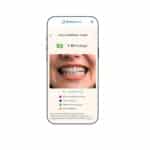
OP What’s the difference between your indirect bonding service and others on the market?
Langlois The main difference is the fact that we utilize our 3-D computer-aided technology to provide unparalleled bracket-placement precision and in-lab bracket positioning based on a doctor-approved digital treatment plan. This approach increases office efficiency and productivity, dramatically reducing overall treatment time by minimizing follow-up appointments for bracket repositioning and wire-bending. We offer IB trays in our original double-tray format, and we are now following the Roncone and OrthoQuest methods as well.
OP How are your digital study models helping the American Board of Orthodontics (ABO)?
Langlois The OrthoCAD 3-D model, together with digital x-rays and digital images, allows the entire ABO case to be digitally graded and submitted, providing the following benefits:
? a permanent record of all ABO-related measurements and scores;
? user-friendly scoring tools that enable candidates to conveniently score pretreatment and posttreatment models prior to submission; and
? the capability to submit the information to the ABO electronically, making ABO submission easier and less expensive.
This means that cases can be discussed and evaluated remotely, without the ABO directors having to convene in a single location. Information can also be used and shared during presentations and interactive university discussions.
OP What’s next at OrthoCAD?
Langlois An intraoral scanner for dental and orthodontic applications. Initially focusing on the crown and bridge market, we will expand our offering to include a scanner capable of capturing full-arch images perfect for orthodontic applications. Our goal is to virtually eliminate the need for traditional analog impressions and materials.
Holding Strong

OP What qualities should an orthodontist look for in a bonding system?
Wilkens The first and most important quality that orthodontists must look for is proven clinical performance. Beyond that, the ideal bonding adhesive should provide strong and reliable bonding and have a balanced viscosity that allows for easy handling and application to the bracket base, while still being firm enough to eliminate bracket drift after placement. Look for published studies, or ask the company to provide quantifiable data that compares their products to other products already in the marketplace. Ortho Technology’s line of Resilience® Bonding Adhesives has more than 15 years of proven clinical performance worldwide and comes with a 100% money-back guarantee.
OP What is the difference between your light-cure and self-cure systems?
Wilkens The Resilience Light-Cure Bonding System provides a more controllable working time and a faster set time due to the fact that the orthodontist can light-cure the bracket when they desire. Whereas the Resilience Self-Cure Bonding System has set working and curing time constraints that the doctor must work within once the material is mixed. Light-cure adhesives have become more popular in recent years due to advancements in curing lights, which have made them more powerful and less expensive. Orthodontists are now able to quickly place and cure brackets with a more efficient process, saving valuable chairtime and ensuring more accurate bracket placement.
OP What products and/or processes do you think will be the future of orthodontic bonding technology?
Wilkens Based on the clinical needs of orthodontists and their desire to provide patients with the best possible treatment results, including enamel that is free of decalcification, I see the future of bonding technology to be in a next-generation bonding adhesive that has all the best properties of a resin-filled composite that creates strong, reliable bonds with a balanced viscosity.
Also, it would be more hydrophilic, or “moisture friendly,” allowing orthodontists to bond in a moist environment for a more forgiving bonding technique. Finally, it would have the fluoride-releasing and recharging feature of resin-modified glass ionomer to ensure there is no decalcification of the patient’s enamel during treatment.










